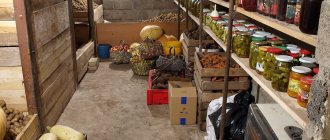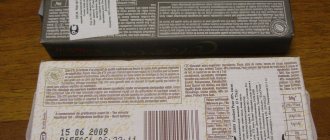Storage conditions for canned meat
Canned food can be sterilized and pasteurized, lunch and snack food. They are made from different types of meat and offal. Spices, salt, cereals, pasta and vegetables are also used.
Canned food is divided into the following types:
- From animal meat. The meat used for cooking is pork, beef, rabbit and lamb. Fat, salt and spices are added to the meat, then sterilized. Canned food can be made from raw, fried and salted meat.
- Offal. These include pates, chopped offal, kidneys in sauce.
- From a bird. Raw meat in its own juice, fried meat in sauce and blanched meat in jelly are used.
- From meat products. These are sausages, salted and smoked products. Ham, sliced bacon, salted bacon, minced sausage.
- Lard and legume products. For cooking, beans and peas are used with the addition of tomato sauce, broth or lard.
- Canned meat and vegetables. They are made from meat or minced meat, adding vegetable raw materials. They can be with cereals, pasta or vegetables.
- Products for dietary and baby food. Canned food for children is made from high quality meat. These are pureed meat products with vegetables and cereals. For adults, dietary liver and meat pates are produced.
Before purchasing, pay attention to the appearance of the container. Bloating indicates fermentation inside the jar - such a product should not be purchased. Don't take dented cans. Any damage can cause depressurization, as a result, bacteria harmful to the body will begin to multiply.
Canned food in glass packaging must be transparent and hermetically sealed, without damage. Dark green glass with slight creases is acceptable.
Store canned products in a dry room at 0...8°C and 75% humidity. Sudden temperature changes are unacceptable.
Meat and vegetable products in glass and tin cans are stored for three years. Stamped - two years. Pasteurized jars - six months, but the temperature should not exceed 5°C.
Important! Always pay attention to the expiration date. Usually it is three years. If you notice that the expiration date is about to expire, it is better to find a fresher product.
Shelf life of stew depending on packaging
Stew can be in a glass, metal jar or plastic bags. The most suitable storage option is metal containers. Stewed meat is stored in them longer, and they are well protected from external factors. The maximum shelf life in such containers can be up to five years. The type of metal and the soldering option play a significant role. The welding method preserves the contents best.
But you can only see the product after opening the can. Glass in this case is more convenient. But the shelf life of the product in a glass jar will be shorter, since the packaging may be exposed to sunlight, which affects the quality of the stew.
It is best to store these canned foods in the refrigerator. According to GOST, stewed meat in glass must be consumed within three years from the date of production.
Stewed meat can be bought not only in the usual jars, but also in plastic retort bags. They are flexible and light. But the shelf life in such packaging is only two years.
Storing stewed meat at room temperature
The stew does not have to be stored in a cool place. It is advisable that the room temperature does not exceed 25°C. In pantries or on a kitchen cabinet shelf, the product will not lose quality until the end of its shelf life.
Stew, which consists only of meat, can be stored for quite a long time - 10-15 years. In order for it to maintain quality and not deteriorate, it is necessary to take into account the following nuances:
- Humidity. If the storage location is too humid, the cans will corrode and the seal will be compromised. You can tell by the rusty spots and plaque. It is better not to buy such canned food, as there may be substances inside that were released during corrosion.
- Temperature conditions. The suitable temperature for storing stewed meat is 0…+25°C. To increase the shelf life of the product, it can be kept in cooler places - for example, in the refrigerator. In this case, the shelf life will increase to six years.
- Integrity of the can. The packaging should not have any damage, dark spots or chips. The label should be clear, without cloudy drawings or letters. If you notice corrosion or dents, this means that the stew was stored incorrectly and should not be eaten.
How to store opened canned food wisely for healthy eating
But even storing an open can in the refrigerator does not guarantee complete safety of the product, since microbes also live inside it. Try making it more secure by using temporary lids to seal your canned food before putting it in the refrigerator.
Here are some simple life hacks you can use.
- Cover the opened jar of leftover canned fish with a glass canning lid.
- A tougher option. The diameters of many tin cans coincide with the dimensions of nylon lids for canning. Soak the lid in hot water for a minute and place it on the jar. It will cool down and wrap very tightly around the neck of the jar. This lid is easy to remove, but if you have difficulty, you can hold the jar for one or two minutes under running hot water from the tap.
- Many coffee can lids will do a great job of temporarily storing open cans.
- Glass lids from tea cups in which tea is brewed can also be suitable for tin cans.
Experts do not have a consensus on the possibility of temporarily storing open canned food in cans. Only on some labels is the information about the need to store an open can in the refrigerator supplemented with the clarification “store in a non-metallic container.” It can be food grade plastic or glass. The fact is that in open metal cans accelerated oxidation begins. Glass is an inert neutral material, so it is preferable to store the contents of open cans in it. Most experts still recommend placing the product from a tin can into another container.
To be sure of the quality of the product, it is better to transfer canned fish into glass containers.
A glass jar will reliably protect canned vegetables. It is better to store canned food in it.
Never risk your health for uneaten food from cans. If you have doubts about their quality, throw them away without regret. Store opened jars only in the refrigerator, transfer their contents to glass containers and always close them with lids.
We recommend: Why do they say that mayonnaise cannot be heated?
Types and shelf life of canned fish
In terms of popularity, canned fish are not inferior to meat. The shelf life depends on the type of fish and the canning option. The date of manufacture and expiration date is indicated on the packaging. Usually it is two years. Manufacturers can also provide information about the product’s shelf life after opening, optimal humidity and temperature.
The range of canned fish includes:
- Fish in oil. For cooking, commercial fish is used. These canned foods are very nutritious. They are made from pre-smoked and dried fish. The filling can be different: sunflower, olive or mustard oil.
- Natural canned food. They are made in their own juice, adding a little vegetable oil. The most common canned foods of this type are cod liver and Far Eastern salmon.
- In tomato sauce. Canned food is made from blanched, fried or raw fish. Minced meat (meatballs, meatballs) is also used. The filling is oil-tomato.
- Canned food in marinade . Hot marinade is added to pre-fried fish. They mainly use sprat or cod.
- Fish plants. Cereals and vegetables are added to such canned food. The most common products of this type are minced fish with rice, gobies with a side dish of vegetables.
- Fish pastes and pates. For preparation, pieces of boiled, smoked or fried fish are used, which are not suitable for the production of conventional canned food. There is also fish paste. Unlike pate, it is more crushed.
The quality of such products can be determined by the type of can and the condition of the contents. It is necessary to pay attention to the color of the fish, smell, consistency and presence of salt. Canned fish should not contain lead, and tin should not exceed 200 mg per 1 kg.
Canned food should be stored at a temperature of 0...+5°C and a humidity of no more than 75%, products in their own juice - up to 10°C, canned oils - up to 20°C. Shelf life depends on storage conditions and type of product. Canned food can be stored from six months to three years.
Important! After the expiration date, defects appear in canned food: sourness, bombing, and a large accumulation of salts. At the same time, the fish darkens and acquires a metallic taste.
There are also preserved fish. Unlike canned food, they are not sterilized. They are made from fish treated with a lot of salt. Preserves are sold in metal and glass jars. The storage temperature of such products is 0…+8°C.
Shelf life of canned food after opening the can
What is the shelf life of opened cans? Canned meat in metal containers can be stored for two days. In a glass jar - seven days. But there is a way to increase the storage duration.
To do this, you will need to transfer the top layer of fat to another bowl. Afterwards, take out the required amount of meat and pour the melted fat over the remaining product. Then cover the jar with a lid and keep it on the top shelf of the refrigerator. This method of re-canning allows you to extend the shelf life up to five months.
Uneaten leftover stew can be frozen by transferring it to a container. The shelf life will be two months.
Preserves and canned fish must be transferred to a glass or ceramic container. The shelf life of the opened product is two days. If the oil completely covers the fish, you can increase the period to four days. Preserves are stored for less time, a maximum of eight hours, since they are not sterilized.
Baby puree should be consumed within 24 hours. The opened jar is kept in the refrigerator.
The corn and peas are immediately transferred to a glass container. There is no need to drain the liquid. The contents are stored for a maximum of two days, after which they are put into a bag and frozen.
Pickled mushrooms should absolutely not be kept in a metal jar after opening. They need to be transferred to another container, preferably glass. Do not pour out the brine. The shelf life of the product is four days.
Where, how and for how long to store canned food in cans
To choose a way to store closed cans at home, let's continue to study the inscriptions on the label. Usually the information is in very small print, so bring a magnifying glass. We are interested in the range of permissible storage temperatures. If it is indicated in the range from 0 to 20-25 degrees, then the jars can and even better be stored in a dry, dark place in the apartment, for example, in a pantry or on a glazed balcony in a closet. Direct sunlight should not fall on canned food. This storage method is preferable to the refrigerator, since it eliminates possible corrosion of the tin due to high humidity. If canned food is opened, it must be stored only in the refrigerator at a temperature of +2 to + 6 degrees. From the moment of opening, the product loses its sterility. At room temperature, pathogenic microbes will begin to rapidly multiply in the product. If they get into the stomach, troubles in the form of cramps, nausea, inflammation of the stomach and intestines and other pain are guaranteed.
Improper storage of open canned food is the second leading cause of poisoning.
The shelf life of food in the refrigerator varies. For example, the manufacturer recommends storing green peas in the refrigerator for up to 12 hours, and squash caviar for no longer than two days. This information is also indicated on the jar label, but not all canned foods. Therefore, let's listen to the opinions of experts. Denis Krivopuskov, candidate of technical sciences, expert technologist on meat products, believes that opened canned meat can be stored in the refrigerator for up to three days. Azmet Tlekhuch, Chairman of the Union of Producers, believes that canned vegetables are safe to store in the refrigerator for up to three days if the jar is tightly closed with a temporary lid. He believes that it is not necessary to transfer them from a tin can, since the tin is coated with food varnish. Evgenia Firsova, an expert on the quality of canned fish, advises storing canned fish in the refrigerator for no more than 24 hours, and be sure to transfer them to another container with a tight lid.
We recommend: How to properly clean mussels at home?











